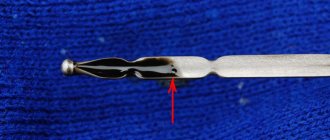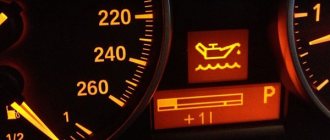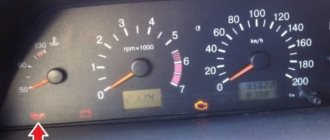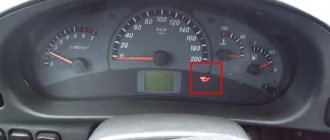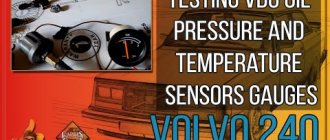The engine lubrication mechanism works to supply automobile oil to the moving parts of the power unit under pressure created by the oil pump. If for various reasons a drop in engine oil pressure occurs, the lubricant will not be able to reach all parts of the unit, which can lead to its breakdown. Therefore, to constantly monitor the level of lubricant pressure, a sensor (light) is located on the dashboard of the car, which, in the event of a malfunction, sends a signal to the driver.
If the oil pressure light comes on while the engine is warm, the driver should quickly stop the car and take all measures to eliminate the problem.
What happens when the oil pressure light comes on on a warm engine?
If problems arise with the pressure level, the engine begins to experience the following problems:
- lack of lubricant;
- wear of moving parts increases;
- the heating of the engine as a whole increases;
- engine cleaning from soot and various deposits is reduced;
- malfunction with subsequent breakdown of bearings;
- Noise in the engine housing increases.
All of the problems listed above ultimately lead to jamming and engine failure.
How to check pressure
If it is not possible to contact a car service in the near future, you can try to find the cause yourself, and for this we need to find out how to check the oil pressure. A special device that measures the pressure in the system is designed for these purposes. It is sold ready-made or you can make it yourself based on any pressure gauge, a rubber hose with a fitting, the thread of which should be the same as that of the oil sensor.
First you need to unscrew the thread on the sensor, preparing for the fact that oil will immediately begin to flow. After this, a pressure gauge is inserted into the system and the engine is started. At the time of startup, a second person must watch the instrument readings. If the value is less than 0.5 kg/cm2, it is necessary to stop the engine.
Diagnosing oil pressure problems
Checking the engine oil level . The cause of the problem may be a small amount of lubricant in the unit.
The reason for the decrease in level may be:
- through damage to the oil pan;
- increased engine consumption due to severe wear;
- increased oil consumption due to waste;
- wear or improper operation of the oil pump.
Having such problems, you need to immediately tow the car to the nearest service station to eliminate the above problems.
Simply adding oil to the required level will not solve the problem. Replacement with lubricant of optimal viscosity . Each brand of car has its own brand of lubricant that must be used during its operation. For example, using 0W20 oil instead of 5W40 leads to severe dilution of the lubricant, since the lubricant used does not comply with the car manufacturer’s recommendations in the manual. This situation can lead to leaks of engine gaskets and seals, which is guaranteed to lead to a decrease in the engine oil level and a drop in its pressure. To avoid getting into such a difficult situation, you need to carefully select the viscosity indicator and other main indicators.
Good to know: Is it possible to add oil to an engine of another brand?
Timely replacement according to the kilometers traveled. It is important to remember that oil may simply lose its protective properties after a certain period of time. It is recommended to replace it after 10-14 thousand km.
Good to know: When should you change the engine oil based on mileage or once a year | How long does it take to change the engine oil
Undesirable mixing with antifreeze. Such troubles can arise from cracks in the cylinder block or from a breakdown of the cylinder head gasket. When antifreeze is mixed with oil, the chemical properties of lubricants change and deteriorate. The first sign of such problems is the presence of an emulsion on the surface of the oil dipstick.
Fuel getting into the engine oil. This problem can arise when the ignition and subsequent combustion of fuel in the engine cylinder is disrupted. As a result, fuel gets into the oil, which greatly dilutes it and leads to a drop in lubricant pressure.
Excessive abuse of various additives. Adding various additives to the oil can also lead to a loss of lubricant quality and ultimately lead to problems.
Good to know: Which motor oil is not counterfeited in Russia, list of the best
Wear of various engine parts. This situation may be caused by an increase in gaps between parts, resulting in a drop in engine pressure and excessive consumption of lubricant. Such problems need to be solved only with the help of a major overhaul of the unit. Various additives will only alleviate the situation temporarily.
Oil receiver filter clogged. If a sufficient amount of lubricant does not pass through this element, the engine will begin to feel a lack of lubricant with all the ensuing negative consequences. The filter may become clogged due to the fact that various types of contaminants have accumulated on the walls of the pan. To solve this problem, you need to clean the oil receiver filter from dirt, thereby solving the problem of engine oil passing through it.
Timely replacement of the oil filter. If the filter is not replaced with a new one in time, it may become clogged and this may ultimately cause a drop in pressure levels. In addition to clogging, the oil filter may be of poor quality, which will negatively affect the operation of the engine lubrication system.
Good to know: Do I need to fill the filter with oil when changing the oil?
Irregular operation of the pressure relief valve. The valve, by its design, remains closed until the pressure exceeds the required norm. But if the valve sometimes sticks in the open position and then it is impossible to obtain the required pressure.
Oil pump failure. If this element breaks down, it must be quickly replaced or repaired. After all, without proper and constant operation of the oil pump, it is impossible to ensure uninterrupted and high-quality lubrication of all rubbing engine parts.
Tips and tricks
Please note that if no leaks are visible, and the oil level and its condition are normal, then before starting complex operations to disassemble the engine, experts recommend accurately measuring the oil pressure in the engine at the initial stage.
Quite often it happens that there is actually nothing wrong with the pressure, and the faults that lead to the warning light coming on are directly related to the wiring and the oil pressure sensor.
The contacts may oxidize over time, and the sensor may also fail. It is quite obvious that these elements also need to be checked first and foremost as part of diagnostic procedures.
"Unfortunate Wind" "Priors"
The Priora engine is not distinguished by any super-revolutionary innovation, and all the “sores” regarding “oil starvation” are inherent in it too. But as we know, the motor is located perpendicular to the longitudinal axis of the car. Due to the geometric configuration of the engine compartment, the jets of incoming air flow around the engine in such a way that sometimes they create an unnecessary headache.
Quite often you can hear that the oil pressure light on a Priora is blinking because dirt (snow, rain) has gotten on the sensor. In such cases, it is enough to clean it of dirt and wipe it dry. Here it makes sense to make a protective screen for the sensor.
Checking the oil filter
Next we move on to checking the oil filter. It is possible for a foreign object (metal shavings, debris, etc.) to get under the shut-off valve, preventing it from closing. As a result, when the engine is stopped, the lubricant from the filter flows into the crankcase. Upon subsequent startup, the oil pressure light blinks at idle until the filter is refilled. The filter itself may also be clogged, preventing sufficient pressure from being created.
Why does the light stay on after the oil has been changed?
Yes, there are times when even after changing the oil, the driver still detects the same signal indicating a failure in the system. The red “oil can” is a reason for both simple and complex problems.
Let's consider a situation where the lamp flashes immediately after turning on the car's ignition. The lack of oil in the engine is to blame here. Measure the level and add, if necessary, the required amount of lubricant.
If low-quality oil or filter was used, the lamp will also get on your nerves with its light. We advise you to choose only those filters recommended by the car manufacturer. It happens that, saving on parts, we often play around with operating the car and then pay several times more for repair work. A defective filter will not be able to contain the oil, so sooner or later you will have to change it. Everyone understands that high-quality components are the key to long-term operation of any unit, including a car engine.
Conclusion
When the oil pressure light comes on, you must quickly turn off the engine and tow the car to the repair site. There can be many reasons for the occurrence of such a problem, so it is impossible to do without comprehensive diagnostics of the unit. It is very important to monitor the main parts of the engine lubrication system to prevent problems with lubrication of the main engine parts.
On the instrument panel in the interior of any car there are light bulbs, the purpose of which is to signal the driver about the presence of certain malfunctions. Each of the indicator lights is connected to its own sensor, which transmits data about a problem or failure that has arisen. In this way, the driver is informed about the occurrence of failures and breakdowns in various vehicle systems. The oil pressure sensor is responsible for the level of lubrication of the rubbing parts of the engine unit. However, for what reasons the oil pressure light may come on and what needs to be done in a particular case, not every driver knows.
Oil pump pressure reducing valve
This small but very important part performs an important function - it prevents the oil pressure from decreasing or increasing. With increased pressure, a number of problems also arise that affect the performance of the motor, namely, the breakdown of key components.
The most common problem is a broken valve spring. It may stretch or break. If this happens, the valve itself must be completely replaced.
Also, over time, the valve lumen becomes clogged. This leads to the fact that when peak speed is reached, the pressure increases sharply.
To prevent this from happening, you need to follow simple rules:
- When checking the level, pay attention to the presence of foreign particles in the oil - ideally it should be transparent;
- Flush the engine before changing the oil;
- Change filters.
The metal mesh of the oil pump is clogged
The main reason is contaminated or low-quality oil. The mesh protects the insides of the pump and motor from contact with large particles.
It is quite difficult to determine exactly why the light comes on - you need to remove the oil pan and assess the condition of the oil. If it is very dirty, then there will be a lot of dirt in the pan.
Gas distribution and crank mechanisms
Well, now to the most serious and extensive reason, from which my head begins to buzz, and the above reasons are not considered anything in comparison with this one.
This is wear of the liners on the timing shaft cushion and on the crankshaft journals, wear of the oil scraper rings on the piston group, deterioration of the cylinder walls, etc. From this moment on, the matter takes on the shape of a major overhaul.
All of the above applies in general to our VAZ classics, and the question of what to do if the oil pressure light on a VAZ is blinking has been given an exhaustive answer. But there is one small addition regarding Priora.
What actions should be taken if the pressure sensor is on?
So, if the sensor lights up while starting the engine, but then does not go out, the first thing you need to do is turn off the engine. It is important to make sure what the oil level is in the system. This can be done using a special probe, or pay attention to the instrument readings on the dashboard.
The fact is that the oil pump takes time to disperse the lubricant throughout the system, fill the channels and pipes in order to create the necessary pressure. This causes the light to light up for 3-5 seconds. A longer period of time when the sensor burns indicates a breakdown, or that there is not enough lubrication in the system. You can try to add lubricant, but there is a danger of overflow. It is necessary to add the substance strictly according to the rules - into a cold car, out of the blue.
